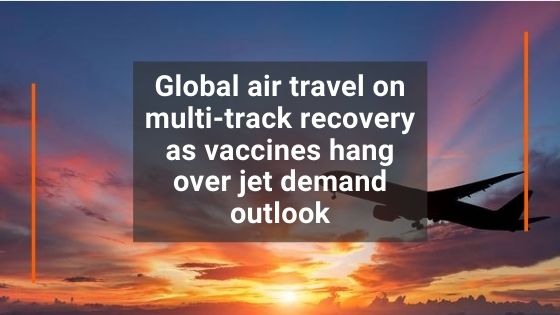Global air travel on multi-track recovery as vaccines hang over jet demand outlook

Published on
GLOBAL AIR TRAVEL CONTINUES TO RECOVER FROM 2020 LOWS BUT LARGE REGIONAL DIFFERENCES REMAIN AND UNCERTAINTIES OVER VACCINE ‘PASSPORTS’ MEAN THE HARD-HIT SECTOR IS SET FOR A SLOW AND BUMPY RETURN TO NORMALITY.
.
Commercial flights, a key proxy for jet fuel demand, recovered to average 68,255 in the week to April 12, according to tracking data from RadarBox.com, the highest since late March 2020 when the first wave of global lockdowns slammed international travel.
Although now at its highest mark since the start of the pandemic, global air travel is still less than two-thirds of comparable 2019 levels and a full recovery is some way off.
In the US, the world’s biggest economy and jet fuel market, domestic flights have rebounded sharply since the start of the year and stand at 76% of 2019 levels, the data showed.
The country’s vaccine rollout and its $1.9 trillion economic stimulus package have triggered a wave of more bullish forecasts for US mobility.
The International Energy Agency on April 14 raised its US oil demand forecast by almost 370,000 b/d in Q3 citing early signs of a surge in gasoline demand and expectations of easing mobility.
US domestic air travel alone was expected to make a full recovery by early 2022, according to a recent report from consulting firm Oliver Wyman.
In China, which brought the pandemic under control before other countries, domestic flights are already well above comparable dates in 2019, the RadarBox.com data showed, although international flights from the world’s number two economy are still heavily curtailed.
Domestic flights have also been growing sharply in Japan and Australia, the data showed, while air travel in India was at 90% of pre-COVID levels despite surging infections.
The air travel recovery in key markets is helping to underpin a stronger demand trajectory for jet fuel, despite expectations it will still be the last fuel to see demand levels return to pre-pandemic levels.
“Global aviation has continued to improve at a fairly steady pace, with a noted solid contribution from the private and business jet segment,” S&P Global Platts Analytics said in a recent note. “Air traffic trends corroborate our expectation for higher jet fuel demand in May and June.”
Platts Analytics sees jet and kerosene demand in the US and China recovering to 1.54 million b/d and 990,000 b/d, respectively, by the year-end. Those levels would corresponded to 89% and 97% of demand at the end of 2019.
Globally, jet and kerosene demand was expected to rise about 200,000 b/d in May versus April and then jump 570,000 b/d in June versus May, according to Platts Analytics.
Weaker regions
Elsewhere, however, a return to ad hoc mobility restrictions to curb rising infections and uncertainty over a return to air travel using vaccine ‘passports’ was weighing on the demand outlook for jet.
Globally, policymakers are debating whether travelers will require proof of vaccination to return to work, travel, or attend events. But a lack of consensus over their scope, adoption, and oversight remains.
In the US, no federal mandate will be given for vaccinations, leaving the burden of proof evidence and how to police it to local governments and the private sector.
In Europe, where the spread of the UK strain of the virus has triggered a return to many new lockdowns, air traffic remains less than a third of 2019 levels, the tracking data showed.
UK flights remain well below pre-COVID levels as the country keeps the lid on mobility despite a fast vaccination rollout. A new ‘Traffic Light’ system designed to support a return to international travel was launched recently.
But ongoing uncertainty saw the move result in over half a million airline seats being removed from schedules for May, according to aviation data provider OAG.
In Brazil, which has seen infections soar on a new COVID-19 variant, domestic flights have flat-lined in the past week after sliding sharply from a post-pandemic high in January.
Globally, Platts Analytics expects demand for jet and kerosene to recover to average 6.24 million b/d this year, up from 4.84 million b/d in 2020 but still 23% below 2019.
With air travel demand expected to be structurally damaged due to behavioral changes as a result of the pandemic, however, Platts Analytics does not expect global jet and kerosene demand to return to 2019 levels of 8.1 million b/d before 2026.




